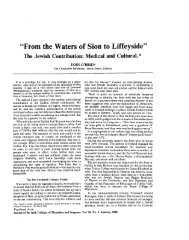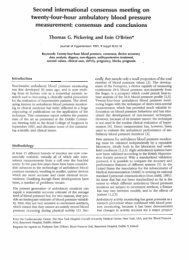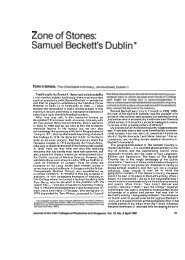Nevill Johnson: Paint the smell of grass - Eoin O'Brien
Nevill Johnson: Paint the smell of grass - Eoin O'Brien
Nevill Johnson: Paint the smell of grass - Eoin O'Brien
You also want an ePaper? Increase the reach of your titles
YUMPU automatically turns print PDFs into web optimized ePapers that Google loves.
my fellows are enjoying <strong>the</strong> unusual experience <strong>of</strong> being in <strong>the</strong> town. We line <strong>the</strong> main street<br />
behind a rope while <strong>the</strong>re pass a succession <strong>of</strong> decorated floats to <strong>the</strong> sound <strong>of</strong> martial music. On<br />
one such float sits a shy Britannia, a local girl with helmet, shield and trident <strong>of</strong> wobbly cardboard.<br />
Our little band, dressed in Norfolk jackets and Eton collars wave Union jacks all but me, that is.<br />
It seems that at <strong>the</strong> age <strong>of</strong> seven I already felt a need to stand aside, to walk against <strong>the</strong> wind.”<br />
Though art was not an influence in young <strong>Johnson</strong>’s life <strong>the</strong>re were at least two influences<br />
that would later become relevant. The “King James bible” springs up in titles <strong>of</strong> many paintings<br />
– how much it was to influence content is debatable, but let us not confuse <strong>the</strong> enduring influence<br />
<strong>of</strong> this work <strong>of</strong> art with religiosity. Also from childhood were <strong>the</strong> pervading evocative influences<br />
<strong>of</strong> sight, sound and <strong>smell</strong>; indeed <strong>Johnson</strong> was to ask <strong>the</strong> same questions that had preoccupied<br />
Proust (and would later do so with Beckett): “When you are nosehigh to a dog adults are but<br />
trowsers and skirts, so my parents and <strong>the</strong>ir friends were quite beyond my horizon. Right now my<br />
world was furnished with sunshine and warm stones, with close up <strong>grass</strong> and shoe-black beetles,<br />
and spiders on stilts. It was abundant with blackberries, and mushrooms budded like manna in<br />
<strong>the</strong> morning.” This artistic sense <strong>of</strong> evocation is fur<strong>the</strong>r examined in a short passage from<br />
<strong>Johnson</strong>’s autobiography The O<strong>the</strong>r Side <strong>of</strong> Six in which he attempts to fathom <strong>the</strong> mind’s<br />
remarkable ability to lock away a stimulus <strong>of</strong> evocation only to release it untarnished many decades<br />
later: “Presently I got to my feet and stood like a dog pointing. A certain <strong>smell</strong>, a perfume,<br />
attracted me, striking a deep memory; it was not <strong>the</strong> clover nor <strong>the</strong> meadowsweet, nor <strong>the</strong><br />
camomile and <strong>the</strong> wild peas. I could not place it and, puzzled, returned to <strong>the</strong> sweet <strong>grass</strong> beside<br />
Sally trying to trace <strong>the</strong> memory. Way back I went – to a child <strong>of</strong> five leaning against <strong>the</strong> bank <strong>of</strong><br />
a country lane in Anglesey in 1916. Some <strong>grass</strong> or flower on that bank released a perfume that<br />
pr<strong>of</strong>oundly affected me; part sweet, part fusty, like cloverhay or dried honeysuckle. For thirty six<br />
years I had remembered this <strong>smell</strong> with a tang <strong>of</strong> sensuality and melancholy, and had searched<br />
long to match this first rapture (for such it was), and on that August evening as <strong>the</strong> birds<br />
commenced to sing, as we brushed <strong>the</strong> seeds from our hair and made for <strong>the</strong> gate, I found it – in<br />
a tangle <strong>of</strong> flowers hanging from laurellike leaves on <strong>the</strong> wall <strong>of</strong> <strong>the</strong> stableyard.”<br />
<strong>Johnson</strong> accepted <strong>the</strong> marvel <strong>of</strong> being that permitted <strong>the</strong> creative process but his thoughts<br />
were never too far removed from <strong>the</strong> scientific basis that facilitates execution <strong>of</strong> <strong>the</strong> wonder<br />
known as art. “It is said that <strong>the</strong> brain is a slightly alkaline electro-chemical computer working on<br />
glucose at 35 watts. Be that as it may I stand always in awe <strong>of</strong> <strong>the</strong> depth and staggering range <strong>of</strong><br />
man’s memory, astonished by this bulging cornucopia – as I am daily surprised that, without heed<br />
or thought I stand upright, or wake in <strong>the</strong> morning. Thus, within <strong>the</strong> convolutions <strong>of</strong> my brain<br />
lie <strong>the</strong> sight and <strong>smell</strong> <strong>of</strong> unnumbered mornings, <strong>of</strong> seals sunning on <strong>the</strong> rocks and plover on <strong>the</strong><br />
wind; <strong>of</strong> streams tumbling turf-brown from <strong>the</strong> flanks <strong>of</strong> Errigal; <strong>of</strong> Muckish glistening and<br />
Binyon, <strong>the</strong> lords and ladies <strong>of</strong> Donegal and Down.”<br />
118 <strong>Nevill</strong> <strong>Johnson</strong> l <strong>Paint</strong> <strong>the</strong> Smell <strong>of</strong> Grass<br />
When <strong>the</strong> time came for <strong>Johnson</strong> to conform, to become a member <strong>of</strong> <strong>the</strong> establishment for<br />
which he had been so well-groomed, it was not to be. He tried – but not for long: “One bleak<br />
morning I visited a hatter’s shop and emerged in a few moments half shamed, half laughing<br />
wearing a bowler hat. Perhaps, thus covered, success would attend me? My fa<strong>the</strong>r and bro<strong>the</strong>r<br />
wore <strong>the</strong>m habitually. Let it be understood that I tried; it was just that my skull was <strong>the</strong> wrong<br />
shape for this adornment. I glanced up repeatedly to <strong>the</strong> driving mirror <strong>the</strong>n pulled impulsively to<br />
<strong>the</strong> curb where I got out to <strong>the</strong> pavement and removed this expensive item from my head. I placed<br />
it upon <strong>the</strong> ground and crushed it with my foot. In this manner did I commit almamatricide.”<br />
<strong>Johnson</strong> fled to ano<strong>the</strong>r part <strong>of</strong> <strong>the</strong> Empire – to Belfast in 1935, shedding in <strong>the</strong> process <strong>the</strong><br />
comfort and security <strong>of</strong> family and business. “There is a primitive within me, I think, that shies<br />
from <strong>the</strong> trap <strong>of</strong> comfort and complacency, which looks askance at rare carpets and <strong>the</strong> second<br />
car, which drips a little bile <strong>of</strong> discontent into our safe havens; a pattern-seeking logic-dodging<br />
ghost, refusing sanctuary and <strong>the</strong> easy option.” So it was to be – <strong>the</strong> future course had been<br />
charted.<br />
But Belfast was a strange place in 1934: “Institutional green and pew brown paint on those<br />
Presbyterian facades, few signs <strong>of</strong> style or culture. The trades basic; <strong>the</strong> making <strong>of</strong> rope and cloth,<br />
<strong>the</strong> building <strong>of</strong> ships. And rife here <strong>the</strong> Calvinist ethic. St Chads and Sedbergh had <strong>of</strong>fered me no<br />
key to unlock <strong>the</strong> secret societies and <strong>the</strong>ir unspoken signals <strong>of</strong> complicity.”<br />
Belfast was <strong>the</strong> beginning <strong>of</strong> <strong>Johnson</strong>’s artistic career. Here he joined a circle <strong>of</strong> writers –<br />
Forrest Reid, Louis MacNeice and John Hewitt, and artists – John Luke and George MacCann.<br />
Luke influenced <strong>Johnson</strong> to take up painting for reasons that are not recorded, but what is evident<br />
is that once launched <strong>Johnson</strong> dedicated himself to painting with an intensity that only waned<br />
when periods <strong>of</strong> doubt obsessed him, as happened from time to time. Luke proved a good master<br />
and he had in <strong>Johnson</strong> a willing and talented pupil: “It has not been revealed how this son <strong>of</strong> a<br />
shipyard worker came to be an artist and pupil <strong>of</strong> <strong>the</strong> Slade, nor do I recall how I first met this<br />
modest man. Suffice to say that he set about to teach me and set me spinning on my courses. For<br />
two years we worked toge<strong>the</strong>r, patient John a good teacher. So, rising before dawn, painting early<br />
and late while earning my keep by day I worked without stint, fuelled by <strong>the</strong> distant hope <strong>of</strong> one<br />
day escaping from business.” The two traveled toge<strong>the</strong>r to Paris where influences abounded: “We<br />
stayed for a time in Paris exploring and tasting rare fruits. Braque and Picasso held sway and <strong>the</strong><br />
surrealists were on stage; Ernst, Magritte and Tanguy, Lipschitz and Gargallo, splendid straightfaced<br />
progenitors <strong>of</strong> <strong>the</strong> fur-lined teacup and <strong>the</strong> spiked flatiron, tripping my pulse. And round<br />
<strong>the</strong> comer fresh young faces – Vivin, Peyronnet, Bombois, children <strong>of</strong> le Douanier, maître de la<br />
réalité. Lifeenhancing stuff it was.”<br />
In Belfast <strong>Johnson</strong> met and married his first wife, Noelle Biehlman, a Frenchwoman from<br />
Versailles, and had two sons. The couple escaped <strong>the</strong> oppressiveness <strong>of</strong> Belfast to <strong>the</strong> countryside<br />
A Personal Memoir l <strong>Eoin</strong> O’Brien 119









